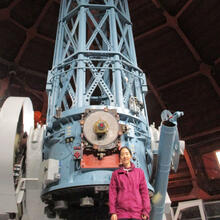
Name:
Eun-Joo Ahn
Position:
Postdoctoral Fellow
What do you do here at Wright Lab?
I’m an active historian of science and a passive particle astrophysicist who studies how science shapes and gets shaped by what goes on around us. I study modern (which means 20th century) astronomy and physics, Asian American scientists of the recent past (mid-20th century to nearly today), and am interested in learning more about the history of Wright Lab.
What is the most unique and/or exciting experience you’ve had here at Wright Lab?
Witnessing all the things happening and progressing at Wright Lab is exciting. I like seeing sort-of-up-close how scientific knowledge-making is progressing, what type of what by who and where, and how they get done. It’s a privilege to be here to see the diverse reserach projects going on. Also, unlike large national labs, it is easier to see how they are done.
What are you looking forward to in the coming year at Wright Lab?
I’m looking forward to learning about the past, present, and future of Wright Lab. I also hope to brush up my dormant astro & physics knowledge and get a glimpse of the groundhog and other urban wildlife, if they will still be around.
What is something that people might not know about you that you’d like to share with the community?
Despite an astronomy and astrophysics background, I’ve worked primarily on or with particles rather than photons—trying to understand the composition of the highest energy cosmic rays.
I became familiar with optical telescopes only when I started studying about Mount Wilson Observatory. This observatory overlooks the Los Angeles basin and was at the forefront of observational astronomy in the first half of the twentieth century, though not anymore, for obvious reasons. The photograph shows me in front of the 60-inch reflector telescope that was commissioned in 1908. Though small by today’s standard, it was the world’s largest working research telescope back then. The 60-inch reflector was used to establish spectroscopic parallax (by Walter Adams and Arnold Kohlschutter) and that our sun is not at the center of the Milky Way Galaxy (by Harlow Shapley).

